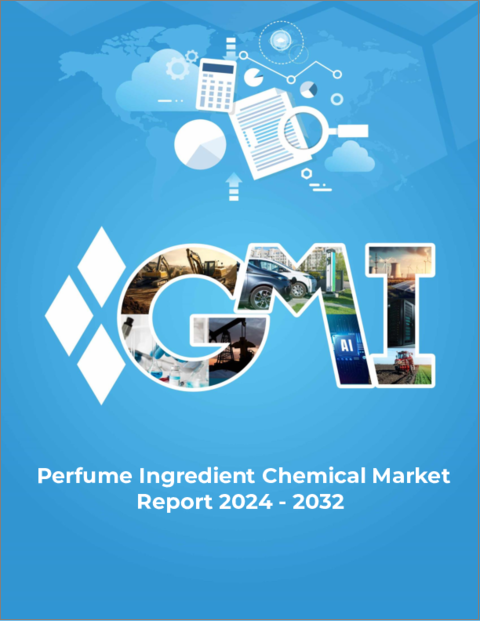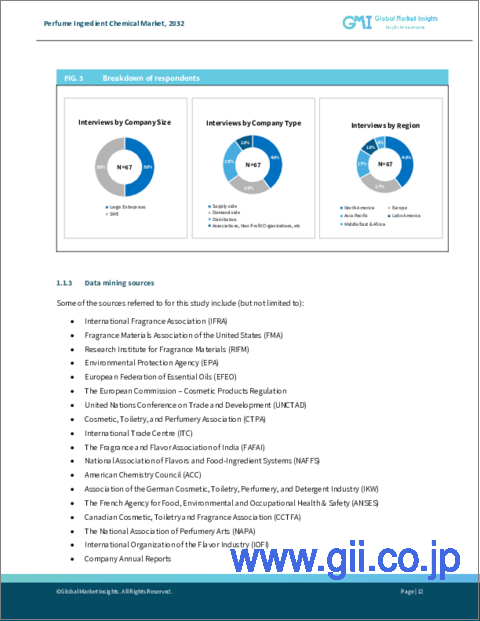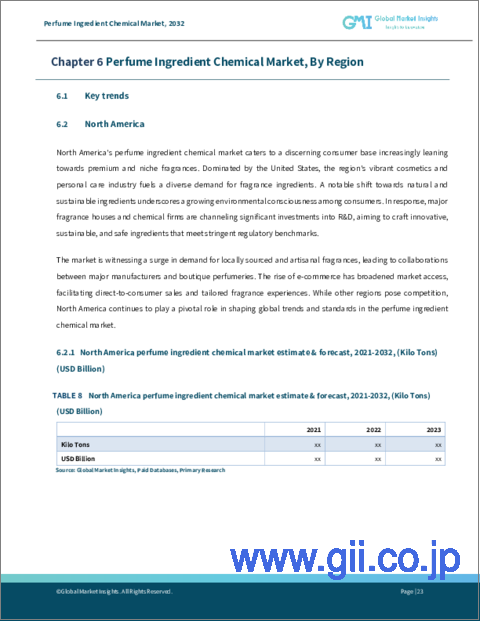|
|
市場調査レポート
商品コード
1573638
パフューム成分化学品市場、機会、成長促進要因、産業動向分析と予測、2024年~2032年Perfume Ingredients Chemicals Market, Opportunity, Growth Drivers, Industry Trend Analysis and Forecast, 2024-2032 |
||||||
カスタマイズ可能
|
|||||||
| パフューム成分化学品市場、機会、成長促進要因、産業動向分析と予測、2024年~2032年 |
|
出版日: 2024年08月23日
発行: Global Market Insights Inc.
ページ情報: 英文 145 Pages
納期: 2~3営業日
|
全表示
- 概要
- 目次
世界のパフューム成分化学品市場は、2023年には約89億米ドルと評価され、2032年には151億米ドルに達すると予測されています。
この成長は、2024年から2032年までのCAGRが6.1%であることを反映しています。市場拡大の原動力は、消費者の嗜好の変化、可処分所得の増加、フレグランス業界の革新です。
消費者は、健康、ウェルネス、持続可能性を求める広範な動向に合わせて、天然成分やオーガニック成分にますます惹かれるようになっています。消費者は、天然で毒性がなく、環境に優しいフレグランスを好み、個人と環境の両方の健康にとってより安全であると認識しています。このシフトは、メーカーにエッセンシャルオイルや植物エキスなどの天然成分をより多く取り入れるよう促し、天然パフューム原料市場を押し上げています。
さらに、贅沢品やパーソナルケア製品への支出の増加が市場の成長を後押ししています。特に新興市場では可処分所得が増加するにつれて、消費者は品質と独自性を提供する高級製品への投資をより厭わなくなります。パフュームは身だしなみの重要な一部であり、こうした支出を行う人気のカテゴリーです。
ステータスと自己表現の象徴としての高級香水の魅力は高まっており、特に若い消費者は、高級天然成分を使用することの多い、職人技の光る高級パフュームに魅力を感じています。
市場は天然成分と合成成分に区分されます。合成原料は2023年に54億米ドルの圧倒的シェアを占め、2032年までにCAGR 5.1%の成長が見込まれます。天然原料は独特の香りが評価される一方で、供給とコストの課題に直面しています。天然香料に対する需要の高まりは、こうした原料への投資の増加を促しているが、合成成分は汎用性と安定性から依然として人気が高いです。
用途別では、市場はファインフレグランス、パーソナルケア製品、家庭用製品、その他に分けられます。パーソナルケア製品分野は2023年に最大の市場シェアを占め、2032年までCAGR 5.7%で成長を続けると予測されています。この成長の原動力となっているのは、化粧品、ヘアケア、スキンケア製品における天然成分やオーガニック成分の嗜好です。ファインフレグランスも市場で重要な位置を占めているが、パーソナルケア製品がそれに僅差で続いています。家庭用製品は安定した市場シェアを維持しており、環境にやさしい処方への注目が高まっています。
欧州は、活気あるフレグランス産業と高級な香りへの需要の高まりによって、世界のパフューム成分化学品市場をリードしています。フランス、イタリア、ドイツなどの国々は、技術革新と伝統的な専門知識を組み合わせて競争力を維持しています。欧州が天然で持続可能な原料に重点を置いていることは、消費者の環境意識の高まりと一致しています。化学物質の使用に関する厳しい規制が研究開発への投資を促し、革新的で適合性の高い処方を育んでいます。このような規制の厳しさと、上質な香りに対する文化的な評価の組み合わせにより、欧州は香水原料用化学品市場の世界リーダーとしての地位を確固たるものとし、世界の動向と基準を打ち立てています。
目次
第1章 調査手法と調査範囲
第2章 エグゼクティブサマリー
第3章 業界洞察
- エコシステム分析
- 主要メーカー
- 流通業者
- 業界全体の利益率
- 業界への影響要因
- 促進要因
- 市場の課題
- 市場機会
- 新たな機会
- 成長可能性分析
- 原材料情勢
- 製造動向
- 技術の進化
- 原材料の持続可能性
- 持続可能な製造
- グリーン・プラクティス
- 脱炭素化
- 価格動向(米ドル/トン)、2021~2032年
- 規制と市場への影響
- ポーター分析
- PESTEL分析
第4章 競合情勢
- イントロダクション
- 企業マトリックス分析
- 企業シェア分析
- 地域別企業シェア分析
- 北米
- 欧州
- アジア太平洋
- ラテンアメリカ
- 中東アフリカ
- 地域別企業シェア分析
- 競合のポジショニング・マトリックス
- 戦略ダッシュボード
第5章 市場規模・予測:タイプ別、2021-2032年
- 主要動向
- 合成成分
- 芳香族化学品
- ムスク化合物
- テルペン
- 天然成分
- エッセンシャルオイル
- アブソリュート
- 樹脂とバルサム
- 動物エキス
第6章 市場規模・予測:用途別、2021-2032年
- 主要動向
- ファインフレグランス
- パフューム
- コロン
- パーソナルケア製品
- 化粧品
- デオドラント
- その他(石鹸、シャンプー、ボディローション)
- 家庭用品
- 芳香剤
- 清掃用品
- その他(医薬品、飲食品)
第7章 市場規模・予測:地域別、2021-2032年
- 主要動向
- 北米
- 米国
- カナダ
- 欧州
- ドイツ
- 英国
- フランス
- イタリア
- スペイン
- アジア太平洋
- 中国
- インド
- 日本
- 韓国
- オーストラリア
- ラテンアメリカ
- ブラジル
- メキシコ
- アルゼンチン
- 中東・アフリカ
- サウジアラビア
- アラブ首長国連邦
- 南アフリカ
第8章 企業プロファイル
- Atul Ltd
- BASF SE
- DSM
- Eternis Fine Chemicals
- Firmenich
- Givuadan
- Godavari Biorefineries Ltd.
- Harmony Organics Pvt. Ltd.
- International Flavors and Fragrances Inc
- KDAC CHEM Pvt. Ltd.
- MANE
- Sensient Technologies Corporation
- Shiseido
- Symrise
The Global Perfume Ingredients Chemicals Market was valued at approximately USD 8.9 billion in 2023 and is projected to reach USD 15.1 billion by 2032. This growth reflects a robust CAGR of 6.1% from 2024 to 2032. The expansion of the market is driven by shifting consumer preferences, rising disposable incomes, and innovations within the fragrance industry.
Consumers are increasingly drawn to natural and organic ingredients, aligning with a broader trend toward health, wellness, and sustainability. They favor fragrances that are natural, non-toxic, and eco-friendly, perceiving them as safer for both personal and environmental health. This shift is prompting manufacturers to incorporate more natural components, such as essential oils and plant extracts, thereby boosting the market for natural perfume ingredients.
Additionally, rising spending on luxury and personal care products is fueling market growth. As disposable incomes increase, especially in emerging markets, consumers are more willing to invest in premium products that offer quality and exclusivity. Perfumes, being a significant part of personal grooming, are a popular category for such expenditure.
The appeal of luxury fragrances as symbols of status and personal expression is growing, with younger consumers particularly attracted to high-end, artisanal perfumes that often use premium natural ingredients.
The market is segmented into natural and synthetic ingredients. Synthetic ingredients held a dominant share of USD 5.4 billion in 2023 and are expected to grow at a CAGR of 5.1% by 2032. While natural ingredients are valued for their distinctive scents, they face supply and cost challenges. The rising demand for natural fragrances is prompting increased investment in these ingredients, though synthetic components remain popular for their versatility and stability.
In terms of application, the market is divided into fine fragrance, personal care products, household products, and others. The personal care products sector held the largest market share in 2023 and is projected to continue growing at a CAGR of 5.7% through 2032. This growth is driven by a preference for natural and organic ingredients in cosmetics, hair care, and skincare products. While fine fragrances also hold a significant market position, they are closely followed by personal care products. Household products maintain a steady market share, increasingly focusing on eco-friendly formulations.
Europe leads the global perfume ingredients chemicals market, driven by a vibrant fragrance industry and increasing demand for luxury scents. Countries such as France, Italy, and Germany combine innovation with traditional expertise to stay competitive. Europe's focus on natural and sustainable ingredients aligns with rising consumer eco-consciousness. Stringent regulations on chemical usage have spurred investments in research and development, fostering innovative and compliant formulations. This combination of regulatory rigor and cultural appreciation for fine fragrances solidifies Europe's position as a global leader in the perfume ingredient chemicals market, setting trends and standards worldwide.
Table of Contents
Chapter 1 Methodology and Scope
- 1.1 Market scope and definition
- 1.2 Base estimates and calculations
- 1.3 Forecast calculation
- 1.4 Data sources
- 1.4.1 Primary
- 1.4.2 Secondary
- 1.4.2.1 Paid sources
- 1.4.2.2 Public sources
Chapter 2 Executive Summary
- 2.1 Industry 360° synopsis
Chapter 3 Industry Insights
- 3.1 Industry ecosystem analysis
- 3.1.1 Key manufacturers
- 3.1.2 Distributors
- 3.1.3 Profit margins across the industry
- 3.2 Industry impact forces
- 3.2.1 Growth drivers
- 3.2.2 Market challenges
- 3.2.3 Market opportunity
- 3.2.3.1 New opportunities
- 3.2.3.2 Growth potential analysis
- 3.3 Raw material landscape
- 3.3.1.1 Manufacturing trends
- 3.3.1.2 Technology evolution
- 3.3.1.3 Sustainability in raw materials
- 3.4 Sustainable manufacturing
- 3.4.1.1 Green practices
- 3.4.1.2 Decarbonization
- 3.5 Pricing trends (USD/Ton), 2021 to 2032
- 3.5.1.1 North America
- 3.5.1.2 Europe
- 3.5.1.3 Asia Pacific
- 3.5.1.4 Latin America
- 3.5.1.5 Middle East and Africa
- 3.6 Regulations and market impact
- 3.7 Porter's analysis
- 3.8 PESTEL analysis
Chapter 4 Competitive Landscape, 2023
- 4.1 Introduction
- 4.2 Company matrix analysis
- 4.3 Company market share analysis
- 4.3.1 Company Market share analysis by region
- 4.3.1.1 North America
- 4.3.1.2 Europe
- 4.3.1.3 Asia Pacific
- 4.3.1.4 Latin America
- 4.3.1.5 Middle East Africa
- 4.3.1 Company Market share analysis by region
- 4.4 Competitive positioning matrix
- 4.5 Strategic dashboard
Chapter 5 Market Size and Forecast, By Type, 2021-2032 (USD Billion, Kilo Tons)
- 5.1 Key trends
- 5.2 Synthetic ingredient
- 5.2.1 Aromatic chemicals
- 5.2.2 Musk chemicals
- 5.2.3 Terpene
- 5.3 Natural ingredients
- 5.3.1 Essential oils
- 5.3.2 Absolutes
- 5.3.3 Resins and balsams
- 5.3.4 Animal extracts
Chapter 6 Market Size and Forecast, By Application, 2021-2032 (USD Billion, Kilo Tons)
- 6.1 Key trends
- 6.2 Fine fragrance
- 6.2.1 Perfumes
- 6.2.2 Colognes
- 6.3 Personal care products
- 6.3.1 Cosmetics
- 6.3.2 Deodorants
- 6.3.3 Others (soap, shampoo, body lotion)
- 6.4 Household products
- 6.4.1 Air fresheners
- 6.4.2 Cleaning products
- 6.5 Others (pharmaceutical, Food and beverage)
Chapter 7 Market Size and Forecast, By Region, 2021-2032 (USD Billion, Kilo Tons)
- 7.1 Key trends
- 7.2 North America
- 7.2.1 U.S.
- 7.2.2 Canada
- 7.3 Europe
- 7.3.1 Germany
- 7.3.2 UK
- 7.3.3 France
- 7.3.4 Italy
- 7.3.5 Spain
- 7.4 Asia Pacific
- 7.4.1 China
- 7.4.2 India
- 7.4.3 Japan
- 7.4.4 South Korea
- 7.4.5 Australia
- 7.5 Latin America
- 7.5.1 Brazil
- 7.5.2 Mexico
- 7.5.3 Argentina
- 7.6 MEA
- 7.6.1 Saudi Arabia
- 7.6.2 UAE
- 7.6.3 South Africa
Chapter 8 Company Profiles
- 8.1 Atul Ltd
- 8.2 BASF SE
- 8.3 DSM
- 8.4 Eternis Fine Chemicals
- 8.5 Firmenich
- 8.6 Givuadan
- 8.7 Godavari Biorefineries Ltd.
- 8.8 Harmony Organics Pvt. Ltd.
- 8.9 International Flavors and Fragrances Inc
- 8.10 KDAC CHEM Pvt. Ltd.
- 8.11 MANE
- 8.12 Sensient Technologies Corporation
- 8.13 Shiseido
- 8.14 Symrise






